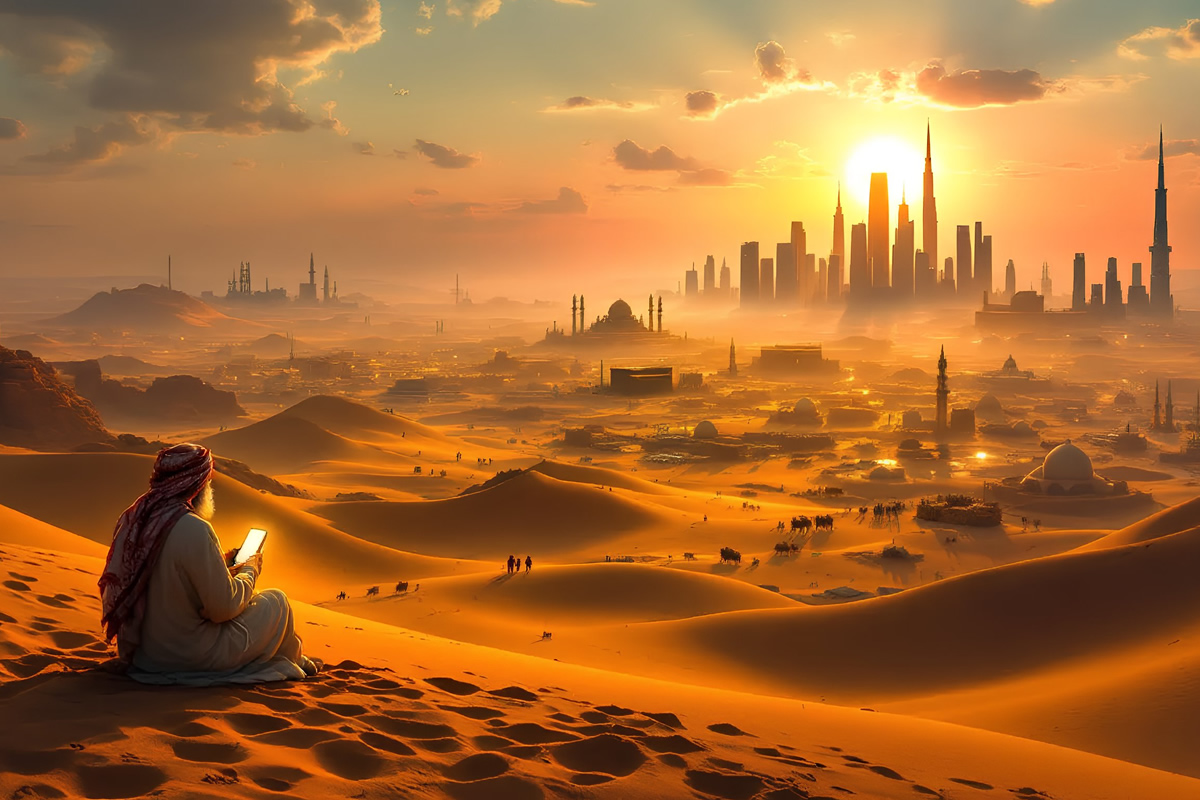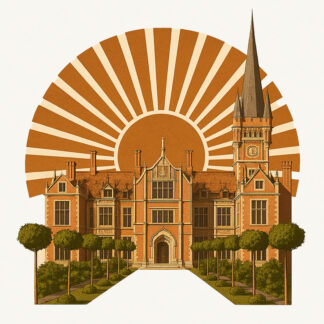Ten thousand years before men built towers of glass and steel, Arabia was green. Rivers threaded through fertile plains; herds of gazelles grazed under acacia trees. The air was thick with the scent of rain, and the wind carried not dust but the breath of life. The land that would one day burn with heat and silence was once a garden where the ancestors of humankind paused on their long migration from Africa to the unknown.
Over centuries, the earth tilted, the skies hardened, and the green retreated. What remained was a sun that ruled like a tyrant and dunes that moved like armies. Water became myth; survival became faith. The people who stayed learned to travel by the stars, to measure life by the taste of dust, to listen to the wind as if it were a god. Out of this silence came the first prayer — not to heaven, but to endurance.
In the south rose kingdoms of stone and incense. The builders of Saba and Hadramaut carved temples to the Sun Goddess Shams and dug canals that tamed the monsoon floods. Their wealth came from the scent of smoke — frankincense and myrrh carried by endless caravans to Egypt, Babylon, and Rome. Gold and silk crossed their ports; songs and languages mixed in the markets of Marib. For a thousand years, Arabia was not a backwater but a bridge — a land of trade and illusion, where gods and merchants shared the same tent.
But power is a guest that never stays. The canals silted, the temples fell, and the wind returned. Empires came to the edges — Babylon, Persia, Byzantium — all looked into the desert and turned away. They saw nothing but emptiness, not realizing that the emptiness itself was power. The desert preserved what the world forgot: discipline, patience, and memory.
The Bedouin was the last free man of the ancient world. His wealth was his word, his map the sky, his home wherever his shadow fell. While empires argued over palaces, he guarded the fire in the sand. In his stories, the past and future intertwined — kings became dust, and prophets were still to come.
When the last rains faded and the dunes took back the land, the desert learned to speak only in whispers. Those who could hear it would one day rise and reshape the world in the name of a new god. The silence of Arabia was not death; it was breath held before revelation.
The Southern Kingdoms and the Gods of Incense (3000–500 BCE)
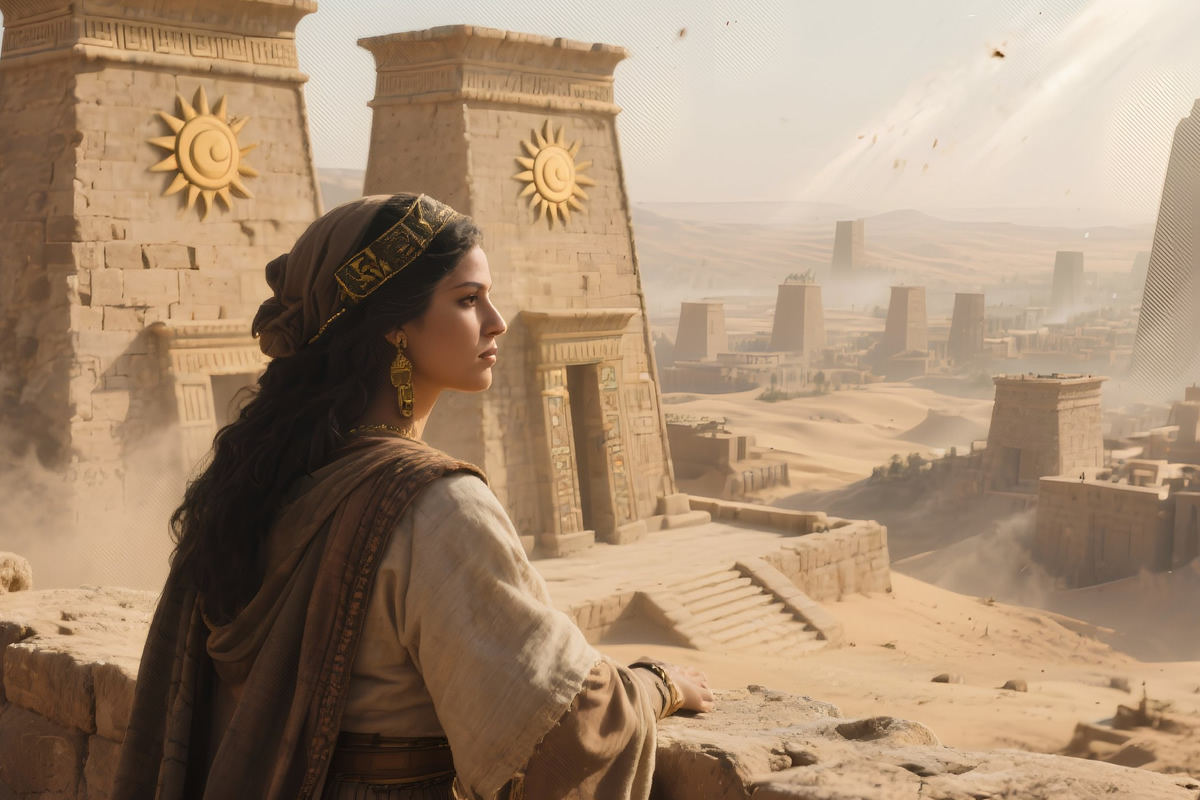
Three thousand years before Alexander, the southern rim of Arabia shimmered with water and light. The highlands of Yemen and the coast of Oman were not seas of sand but terraces of green, irrigated by canals carved into the mountains. Rain fell with the monsoon winds, feeding valleys that would one day turn to dust. From this soil rose cities that looked like mirages — Saba, Hadramaut, Qataban — the first kingdoms of the desert, built not by conquest but by calculation.
Their secret was scent. From the trunks of Boswellia and Commiphora trees bled drops of resin — frankincense and myrrh — hardened tears that burned with divine smoke. These resins were rarer than gold and purer than metal. They traveled north to Egypt, Babylon, and the Levant, perfuming temples and tombs alike. Every civilization prayed in Arabian fragrance. Without Arabia, no god would have smelled divine.
The trade routes were arteries through which the ancient world breathed. Caravans stretched across the desert in single-file columns, hundreds of camels laden with resin, spices, and silver. The routes wound from the ports of Aden to the markets of Gaza and Damascus. Each oasis had its tribute; each tribe its toll. The Sabaeans learned the arithmetic of diplomacy — gold for peace, smoke for loyalty, and silence for survival.
In Ma’rib, the capital of Saba, rose the great dam — an engineering wonder of stone and sand. It caught the monsoon floods and released them through canals that fed orchards of grapes and pomegranates. The dam was the heart of a civilization that measured time by harvests, not wars. Here, religion was administration: priests kept ledgers, rituals were schedules, and devotion was logistics. The gods demanded precision more than sacrifice.
The Queen of Saba, later known as Bilqis, embodied the alliance between faith and profit. Her reign, somewhere around the tenth century BCE, turned commerce into diplomacy. The story of her visit to King Solomon was no romance; it was a negotiation between two merchant monarchs — gold for wisdom, incense for alliance. Through her, Arabia spoke with the voice of power that needed no army, only control of desire.
Prosperity drew attention. Egypt and Babylon watched the incense routes like hunters stalking prey. Pirates raided the Red Sea; rival tribes ambushed caravans. The Sabaeans responded not with soldiers but accountants. They taxed the gods themselves — charging priests and pilgrims for the privilege of burning incense. Wealth turned sacred, and sacred turned routine. What began as devotion became the first global monopoly.
But power decays like all fragrance. Centuries of wealth bred complacency. The irrigation channels clogged, the dam of Ma’rib cracked, and the once-green terraces withered. Civil wars broke trade into fragments; rival kingdoms — Ma’in, Qataban, Hadramaut — fought for routes already fading. By the first millennium BCE, new players from the north, the Nabataeans, seized control. The desert reclaimed its quiet, and the gods of smoke vanished into memory.
Yet Arabia forgot nothing. The Sabaeans left behind their language, carved in stone, the ancestor of Arabic script. Their cities became ruins, but their idea endured: that faith and commerce are twins, that piety can be traded, and that survival demands negotiation. When, centuries later, a merchant from Mecca would claim revelation in a cave, he was walking in the footsteps of the Sabaean priests — heirs to the first empire of the scent.
Empires of the Caravan (1000–100 BCE)

By the first millennium before Christ, Arabia was no longer an isolated peninsula of mirages and incense trees. The desert had turned into a map of roads — the arteries of the ancient economy — stretching from the Red Sea to Mesopotamia. At every horizon, a caravan appeared like a moving city, its bells echoing through the dunes. These were not the soldiers of empire, but merchants who carried the gods, languages, and luxuries of the world on the backs of camels. The scent of frankincense, the gleam of gold, and the rumor of new creeds moved together through the sand.
The Nabataeans of the north, once wandering tribes, built their capital at Petra — a fortress of red rock carved by wind and ambition. Their city was invisible until you were already inside it, hidden behind narrow canyons that swallowed intruders whole. From Petra, they controlled the incense routes like toll gates between worlds. Every merchant who sought to reach Damascus or Gaza paid tribute to the desert lords. The Nabataeans built no palaces of marble; their wealth was in the silence between two dunes.
Further north, the city of Palmyra rose like a mirage on the edge of the Syrian steppe — half Greek, half Arab, fluent in every language of profit. Its columns were carved in the style of Athens, but its heart beat to the rhythm of the desert. Greek philosophers, Persian traders, Aramaic scribes, and Arab chieftains walked its streets. Gold changed hands in twenty tongues, and under every bargain lay the quiet threat of the camel-mounted guards who made sure peace remained profitable.
Rome, ever hungry, tried to reach the source of this invisible wealth. Around 26 BCE, Aelius Gallus led a Roman army deep into Arabia Felix, the “Fortunate Arabia” they believed was paved with gold. The expedition ended in fever, thirst, and retreat. The desert defeated the legions as easily as it once erased the Sabaeans. Rome learned what all empires would: Arabia could be traded with, bribed, even flattered — but never ruled.
The Persians and the Byzantines, wiser than Rome, chose infiltration over invasion. They sent emissaries, priests, and merchants instead of armies. Churches and fire temples appeared along the caravan roads, standing beside pagan shrines to the moon and sun. The gods of Arabia multiplied like caravans — Almaqah, Hubal, Ba’al, and dozens of local deities sharing the same sky. The desert absorbed them all, reshaping each into its own likeness: stern, distant, and enduring.
At every oasis, language changed shape. The alphabet of Saba morphed into the scripts of Nabataea and later into early Arabic. Trade was not only goods; it was ideas encoded in words, laws, and contracts. The merchant became a priest and diplomat, his honesty a matter of survival. To cheat in trade was to betray one’s tribe. In these exchanges, the ethics of the future Islam were already being rehearsed — unity in speech, faith in trust, and judgment in debt.
The power of these caravan empires rested not on walls but on reputation. A tribe that broke an oath was erased faster than a city burned. The desert punished arrogance and rewarded cunning. For centuries, wealth flowed not from kings or armies but from the unwritten law that kept routes safe: mutual need disguised as honor. It was commerce that tamed chaos, and belief that gave commerce its legitimacy.
By the first century before Christ, the desert was again changing hands. New powers — Parthia, Rome, and the kingdoms of Judea — surrounded Arabia like closing fists. Yet the caravans continued, indifferent to borders. The Nabataeans flourished for a while longer before fading into dust, their stone facades swallowed by the sand. But the network they built remained — invisible, enduring, sacred in its logic. When prophets later spoke of unity, revelation, and pilgrimage, they would be walking the same paths once ruled by merchants who understood the first truth of the desert: everything passes, but the route endures.
Markets, Tribes, and Prophets (1st–6th Centuries CE)
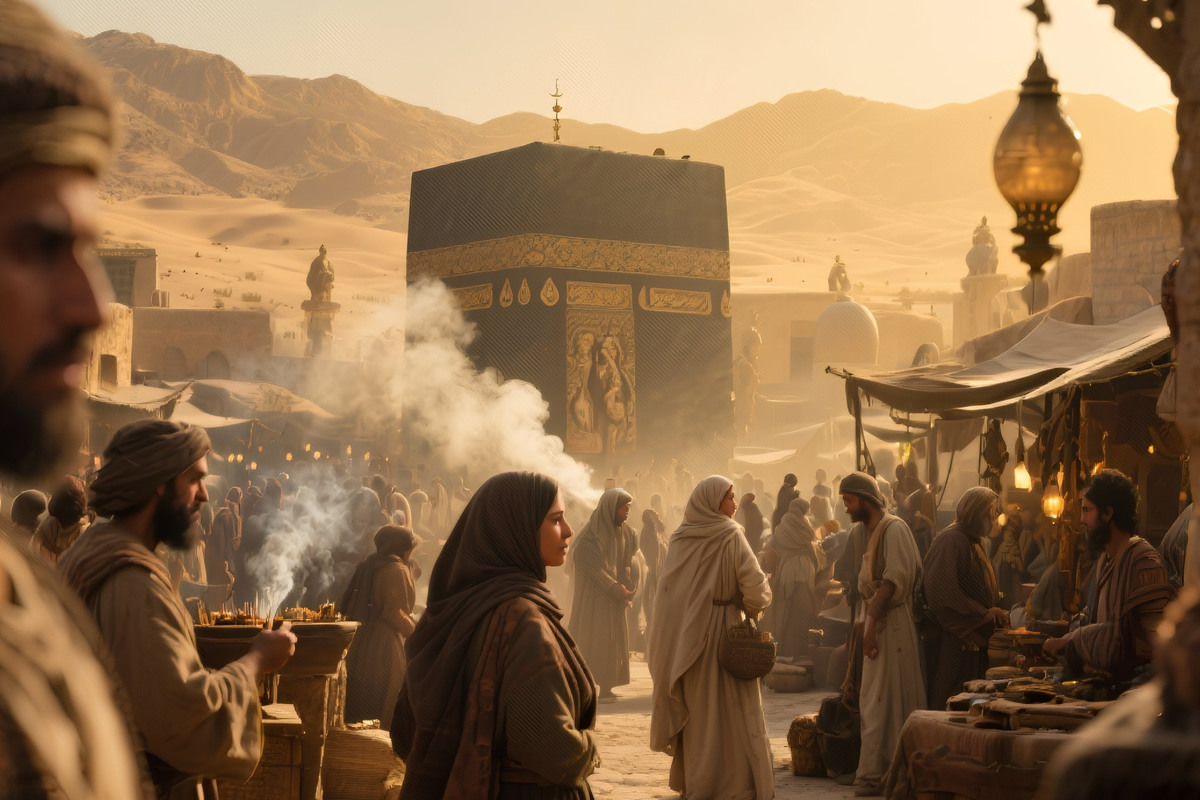
By the dawn of the first century, the world had changed, but Arabia remained suspended between epochs — too proud to be conquered, too poor to be ignored. The old incense kingdoms had vanished, leaving only ruins and echoes, yet the trade routes still pulsed with movement. Caravans now carried silk from China, pearls from the Gulf, ivory from Africa, and slaves from everywhere. Arabia was the hinge of continents, the place where the world’s goods and gods brushed shoulders in the dust. The desert was no longer a mystery — it was an economy.
In the northwest, the Nabataean kingdom of Petra declined under Roman shadow, while new centers emerged farther south. Yathrib, later called Medina, grew around its oasis like a green scar on the map. Mecca, meanwhile, sat at the crossroads of trade routes that bound Yemen to Syria and the Indian Ocean to the Mediterranean. It was a city without rivers or walls, yet merchants from all horizons gathered there, drawn by profit and pilgrimage. The Kaaba — a cube of black stone draped in cloth — stood at the center, a shrine to hundreds of gods. It was both temple and market, the heart of a city built on bargaining with heaven.
Religion in Arabia was a cacophony. Pagan tribes worshipped celestial bodies, stones, and spirits that haunted wells and winds. Jewish tribes had taken root in Yathrib and Khaybar after Roman persecutions in Palestine, bringing the law of Moses into the desert. Christian missionaries from Abyssinia and Byzantium wandered from village to village, preaching salvation in broken Arabic. Around every fire, someone claimed prophecy, and every tribe believed it was chosen. The peninsula was saturated with revelation, yet starved for truth.
The great empires — Byzantium to the north, Persia to the east — eyed Arabia as a corridor, not a prize. They fought each other endlessly, burning cities and draining treasuries, but they needed the Arabs. The desert tribes guarded the lifelines between the two empires, hired alternately as mercenaries, couriers, or raiders. Some tribes converted to Christianity to gain Byzantine favor, others to Zoroastrianism for Persian gold, but most clung to the freedom of their gods and their swords. For them, faith was a contract like any other: valid only while it paid.
The tribes themselves were nations in miniature — self-governing, armed, and endlessly proud. Loyalty flowed through bloodlines, not borders. To protect one’s honor was holier than to pray. A man without a tribe was already dead. Poetry became the battlefield of reputation: verses recited before battle, love, or vengeance. Through these songs, the Arabs recorded their genealogies, their grudges, their dreams. Long before the Qur’an, poetry was the scripture of the desert — the only art that survived the sand.
Mecca’s ruling clan, the Quraysh, mastered the art of neutrality. They offered safe passage to all caravans and taxed every god equally. Their annual fairs at Ukaz mixed trade with diplomacy: merchants weighed gold, poets competed in rhetoric, and chieftains settled wars over cups of spiced wine. The Kaaba, filled with idols from across the peninsula, was not a contradiction — it was a business model. Each tribe saw its deity represented, and in the shadows, the Quraysh counted the offerings. In this system, piety was profit, and the sacred was an economy disguised as devotion.
But beneath the noise of trade and poetry, a tension grew. The Jews spoke of one God, the Christians of one Savior, the Persians of one cosmic struggle. The Arabs, surrounded by empires of monotheism, began to question the old idols carved from wood and stone. Some sought solitude in the mountains; others fasted in the desert, hoping for a sign. The air of Arabia was heavy with waiting, as if the wind itself knew that something vast was about to break the silence.
By the sixth century, Mecca had become the stage for this unseen drama — a city ruled by merchants yet haunted by prophecy. Trade was strong, but the soul of Arabia was restless. The old gods felt tired; the rituals repeated without conviction. In the cool nights, among the dunes, the shepherds still looked to the stars for guidance, unaware that one among them would soon speak in a voice that would change the world. The age of merchants was ending; the age of revelation was about to begin.
Muhammad and the Desert Revolution (610–632 CE)
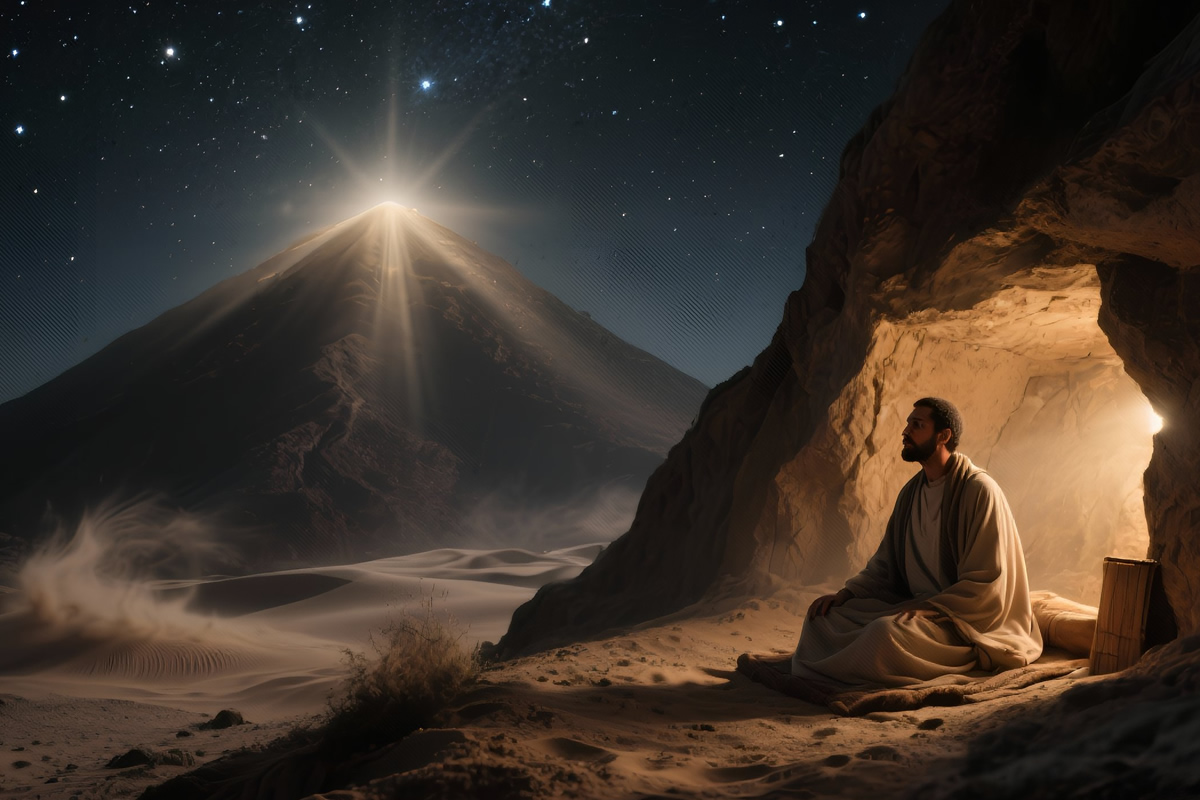
It begins in silence. A man stands alone in a cave on the slopes of Mount Hira, outside Mecca. The year is six hundred and ten. The desert wind moans through the stones as he prays, seeking meaning in a world of idols and debts. Then comes the voice — neither human nor mortal — commanding him to read. He trembles, protests that he cannot, and the voice replies again: Read, in the name of your Lord who created. The sound fills the cave like fire, and the man — Muhammad ibn Abdullah — descends the mountain carrying a message that will tear his world apart.
Mecca, city of commerce and compromise, had no patience for prophets. Its rulers, the Quraysh, feared one god more than a thousand, for unity threatened their trade. The Kaaba, crowded with idols, was the city’s treasury; every tribe’s god meant another customer. Muhammad’s words — that God was one and all men equal — were bad economics. Merchants laughed, poets mocked, slaves listened. The more he preached, the more dangerous he became.
Persecution followed. His followers were beaten, exiled, or enslaved. Some fled across the Red Sea to Christian Abyssinia, where a king, impressed by their faith, granted them refuge. The prophet stayed, teaching in secret, defying the Quraysh’s boycotts and bribes. When his uncle, Abu Talib, and his wife, Khadija, died, the city closed around him like a fist. Then came the invitation from Yathrib — a northern oasis torn by tribal feuds — to serve as mediator. Muhammad left Mecca under the cover of night. The journey, later called the Hijra, would mark the birth of a new calendar and a new civilization.
In Medina, religion became government. Muhammad forged a pact among warring clans, creating a community bound not by blood but belief — the Ummah. He built a simple mosque from palm trunks, led prayers, judged disputes, and commanded armies. Faith was no longer private; it was political. The Qur’an, revealed in fragments, became the constitution of this fragile state. The Prophet was no longer only a messenger — he was a ruler of men, a strategist of survival.
War was inevitable. Mecca could not tolerate a rival prophet or his growing followers. In 624 came the Battle of Badr — three hundred Muslims against a thousand Meccans. Against all reason, the believers won. They saw angels in the dust, divine justice in their swords. A year later at Uhud, they were nearly destroyed; at the Battle of the Trench, they survived by ingenuity, digging defenses while the enemy starved. Each struggle bound the community tighter, turning faith into discipline and revelation into policy.
As victory replaced fear, Muhammad redefined Arabia. Tribes once united only by vengeance swore allegiance to the Ummah. Tax replaced tribute; law replaced revenge. The Qur’an condemned usury, blood feuds, and the worship of stone. Yet it also absorbed the best of tribal ethics — honor, loyalty, and generosity — translating them into divine commandments. The desert’s old virtues found a new flag. Arabia, for the first time in history, had a single idea strong enough to outlive a generation.
In 630, Muhammad returned to Mecca at the head of ten thousand followers. The Quraysh surrendered without a fight. He entered the city on a camel, bowed his head, and ordered the idols in the Kaaba destroyed. The stone that once represented a marketplace of gods became the center of one God’s world. Forgiveness, not vengeance, marked his victory — a gesture that turned enemies into believers. Within two years, most of Arabia followed him.
In 632, the prophet died in Medina, the city he had made his capital. He left no crown, no palace, no heirs — only words. His final sermon warned that no man was above another except in piety. When he was gone, his followers wept as if the sun itself had vanished. Yet his vision endured. In a generation, it would become an empire; in a century, a civilization. The desert that once sold the scent of gods now produced its own — invisible, absolute, and eternal. The silence of Hira had spoken, and the world would never forget its echo.
Caliphates and the Lost Center (632–1258 CE)
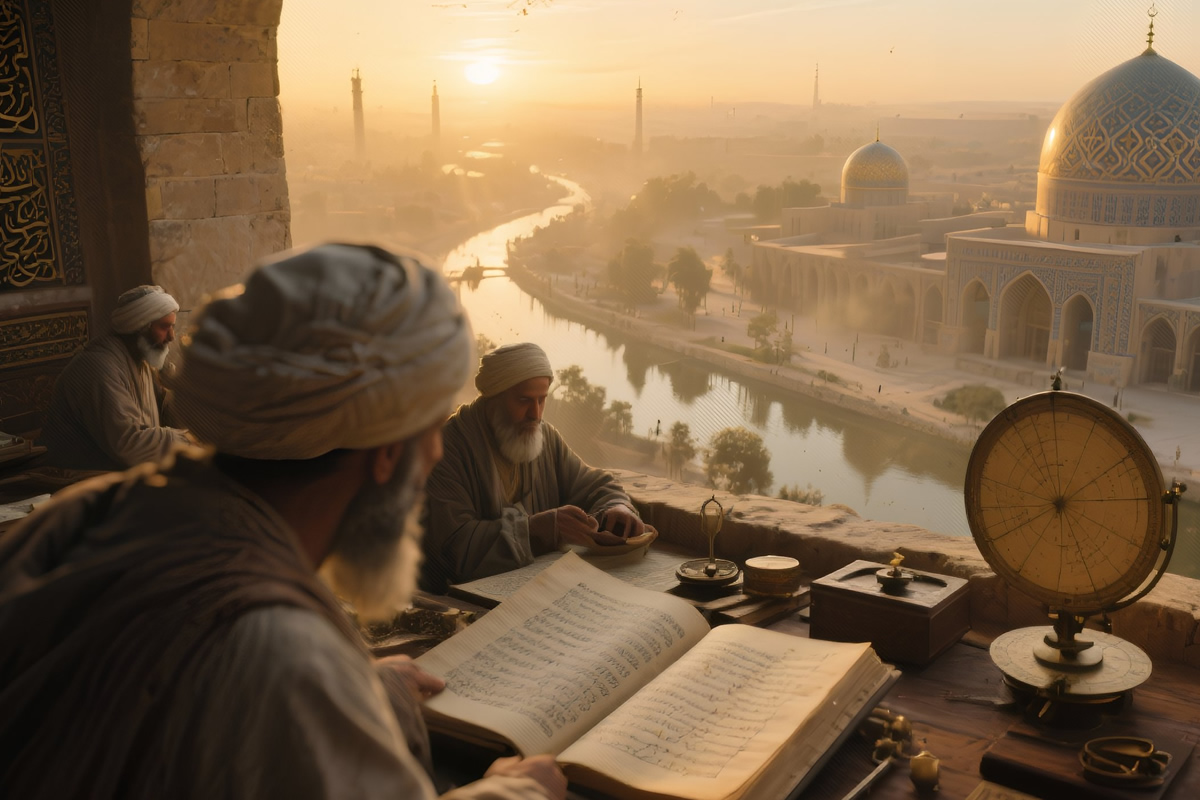
When Muhammad died in 632, Arabia was united but fragile, a body without its heart. No prophet remained to speak with God, only men to interpret his words. From this uncertainty rose the first caliph, Abu Bakr, who swore that faith would not die with the man who carried it. He crushed revolts among the tribes and sent armies beyond the desert, claiming that Islam was not only a revelation but a mission. Within two years, the peninsula that once defied empires was marching to conquer them.
Under Caliph Umar, the Arabs became something they had never been before — imperial. They stormed into Persia, seized Damascus, and took Egypt from Byzantium. The desert horsemen, hardened by scarcity, met the world’s great armies and found them soft. By mid-century, Arab banners flew from the Nile to the Oxus. In a single generation, the conquered had become conquerors. But the victories carried danger: the faith of the Prophet had promised equality, yet the empire was built on rank, taxes, and tribute. The Bedouin ideal of freedom began to choke on its own success.
The third caliph, Uthman, compiled the Qur’an into one canon, fearing that conquest would fragment revelation. His attempt at order bred resentment — accusations of nepotism, luxury, and corruption filled Medina. He was murdered by rebels, and Ali, Muhammad’s cousin and son-in-law, took the caliphate. His rule split the believers. The struggle between Ali and his rival Muawiya, the governor of Syria, tore Islam into factions. In 661, Ali was assassinated, and Muawiya founded the Umayyad dynasty in Damascus — a monarchy disguised as a caliphate. The age of faith’s purity was over; the age of politics had begun.
Under the Umayyads, the empire expanded to its limits — across North Africa into Spain in the west and into Central Asia in the east. Arabic became the language of law, trade, and poetry. Gold coins bore verses of the Qur’an; mosques replaced temples; desert tribes became administrators and governors. Yet in Mecca and Medina, the heart of Islam grew quiet. The holy cities turned into symbols, visited by pilgrims but ruled from afar. Arabia had birthed an empire, but the empire no longer needed Arabia.
In 750, revolution arrived. The Abbasids, claiming descent from the Prophet’s uncle, overthrew the Umayyads and moved the capital to Baghdad — a city of gardens, canals, and scholars. Here, the desert turned into marble and ink. The Abbasids built libraries larger than temples, observatories taller than towers. From Greek and Persian manuscripts, they translated philosophy, medicine, and mathematics — creating the Golden Age of Islam. The desert’s sons, once illiterate traders, became the curators of global knowledge.
But prosperity breeds the same decay in every age. Court intrigue, sectarian wars, and provincial revolts fractured the unity that conquest had forged. Shia dynasties rose in Egypt, Persian sultans ruled in Iran, Berbers in Morocco, Turks in Anatolia. The caliph’s authority shrank to ceremony; his empire became a quilt of competing powers bound only by language and faith. Yet through this fragmentation, Mecca remained untouchable — a single black cube that outlasted every throne.
While Baghdad glittered, Arabia itself sank into obscurity. The pilgrims still came, crossing deserts with camels and prayer, but the region produced no scholars, no rulers, no armies. The desert had returned to its ancient role — supplier of faith, not power. Traders from Yemen still carried spices and cloth to Africa and India, but the true wealth of Islam now flowed north. The peninsula, once the center of revelation, had become its museum.
In 1258, Mongol horsemen stormed Baghdad, burning its libraries and drowning the Abbasid dynasty in the Tigris. The light of the Golden Age went out, and Islam’s unity was shattered for centuries. Yet the Kaaba stood untouched, pilgrims circling as they had since the Prophet’s day. Arabia, forgotten by the world it once conquered, remained the custodian of its memory — a silent witness to empires that rose on its words and fell by their own ambition. The desert had given the world a voice and then, as always, kept its silence.
Ottoman Shadow and Wahhabi Fire (1517–1918)
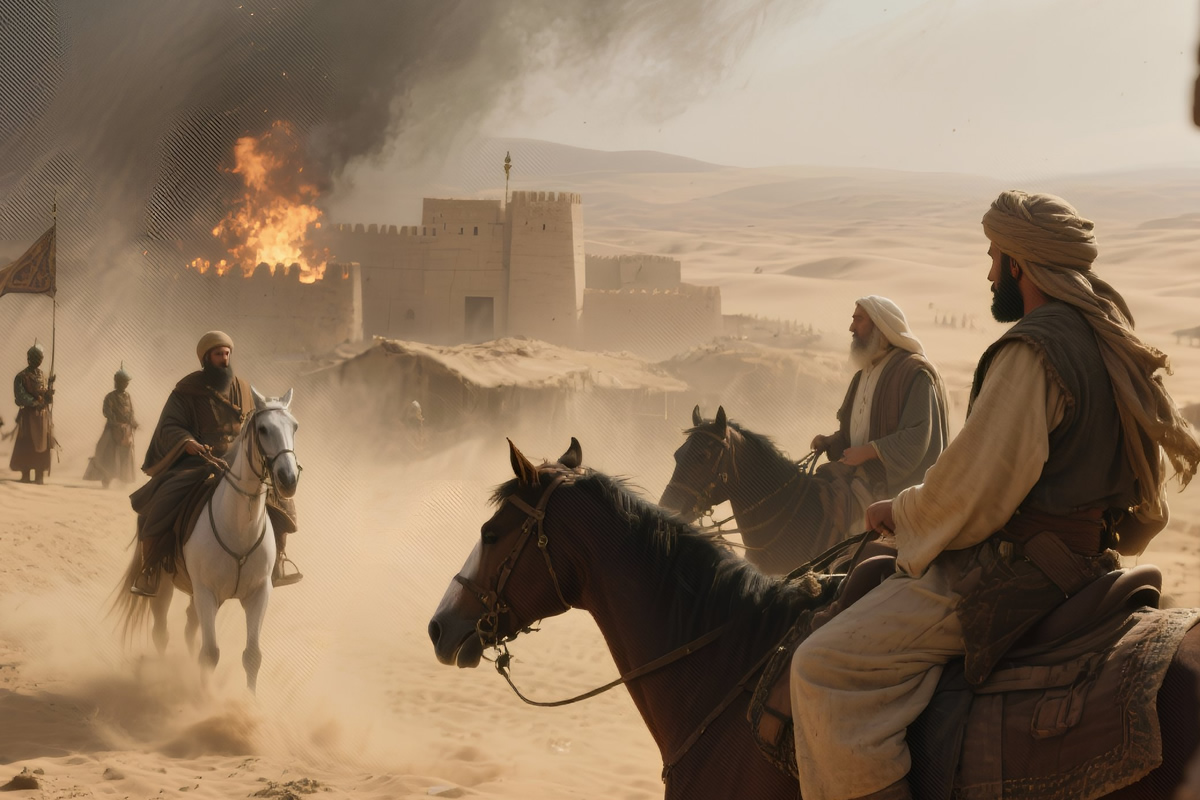
By the sixteenth century, the once-mighty Arabian Peninsula had become a forgotten frontier. Empires rose and fell around it — Portuguese sailors mapped its coasts, Persian shahs eyed its ports, and Mamluk sultans taxed its pilgrims — but the desert remained what it always was: a kingdom of tribes and faith. Then in 1517, the Ottoman sultan Selim I conquered Egypt and claimed the title of Caliph, inheriting guardianship of Islam’s holiest cities. Mecca and Medina passed into imperial hands, but the Ottomans ruled them from afar. Garrisoned Turks collected taxes, appointed local sharifs, and left the desert to govern itself. Arabia became a province of someone else’s piety.
The centuries that followed were quiet in the way deserts are — silence masking rebellion. Ottoman influence barely reached beyond the Hijaz coast. In the interior, tribal alliances fought endless skirmishes for wells and pasture. Power belonged to whoever controlled water and pilgrimage routes. Local emirs traded allegiance like currency, swearing loyalty to Istanbul when convenient, and raiding their neighbors when not. The empire claimed authority, but its soldiers never understood the sand they walked on. Arabia was too vast to own, too poor to matter, and too proud to submit.
In the eighteenth century, a different kind of fire spread through the dunes — not political, but religious. In the dusty town of Diriyah, in central Najd, a scholar named Muhammad ibn Abd al-Wahhab began preaching against the corruption of Islam. He denounced the saints, shrines, and mystics that filled Ottoman Islam, calling them heresy. His message was raw, severe, and irresistible: return to the faith of the Prophet, destroy the idols, purify the creed. He promised salvation through simplicity and power through unity. It was a theology built for a desert that had grown tired of compromise.
Wahhab’s words found their sword in a tribal leader named Muhammad ibn Saud. The preacher and the emir struck a pact — religion for legitimacy, legitimacy for protection. Together they began conquering Najd, uniting tribes under a banner that read simply, There is no god but God. Villages that resisted were burned, shrines leveled, scholars exiled. What began as reform turned into revolution. For the first time in centuries, Arabia spoke in one voice — austere, militant, unyielding.
The Ottomans, preoccupied with European wars, underestimated the threat until it was too late. By the early nineteenth century, the Wahhabi–Saud alliance had seized Mecca and Medina, shocking the Muslim world. Pilgrims found the tombs of saints destroyed and centuries of decoration stripped away. The holy cities had not seen such fervor since the age of the Prophet. Istanbul responded with fury. In 1818, Ottoman-Egyptian forces under Muhammad Ali crushed Diriyah, executed its leaders, and razed the town. The empire reasserted control, but it was a victory that could not erase an idea. Wahhabism survived — waiting.
Throughout the nineteenth century, British ships appeared along Arabia’s eastern coast. They came not for faith but for fuel — coal, pearls, and routes to India. The British made treaties with coastal sheikhs of Bahrain, Kuwait, and the Trucial States, promising protection in exchange for obedience. On the surface, they fought piracy; in truth, they secured empire. Arabia was once again divided — the Ottomans holding the west, the British anchoring the east, and the tribes trapped in between. Every tribe learned to navigate the new order: swear loyalty to both, betray neither too soon.
Inland, the Saud family rebuilt their strength. A second Saudi state rose in Riyadh, fell again, and rose once more. The pattern was endless: conquest, betrayal, retreat, revenge. Wahhabi preachers followed every campaign, declaring each victory divine. The movement’s genius lay in its dual nature — spiritual for the poor, political for the ambitious. Its message was simple enough for shepherds and sharp enough for kings. When the Ottomans called them heretics, they called themselves purifiers. The desert listened and chose the louder creed.
By the dawn of the twentieth century, the Ottoman Empire was crumbling under its own weight. Railroads and telegraphs reached the Hijaz, but loyalty did not. The empire’s modernity arrived too late, and its faith too thin. In the heart of the desert, the heirs of Ibn Saud prepared for their final return. The British, eager to undermine Istanbul, supplied weapons and gold. Faith met empire, and empire met opportunity. The stage was set for the twentieth century’s most unlikely miracle — the rebirth of a kingdom from the dust of both the Qur’an and colonial ambition. The desert, patient as ever, was ready to choose a new master.
Britain’s Arabia: A Colony of Sand (1914–1932)
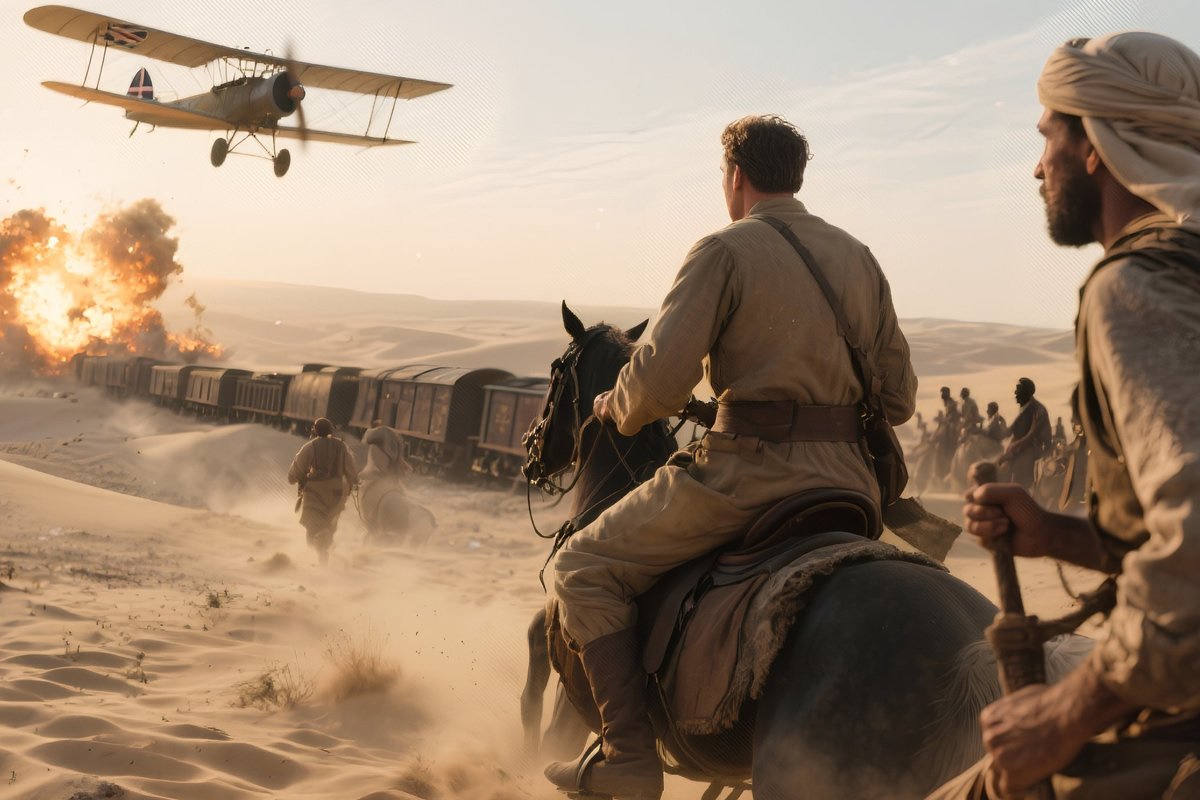
The First World War reached Arabia not through armies but through rumors and gold. The Ottoman Empire, sick and sprawling, clung to its provinces like a dying beast. London saw opportunity in its weakness. For Britain, the desert was not empty — it was a route, a weapon, and a promise. Oil had been discovered in Persia a few years earlier; control of the Middle East was no longer about faith or geography, but fuel. In 1914, the British Navy switched from coal to oil, and suddenly the dunes of Arabia gleamed brighter than gold.
To ignite revolt against the Ottomans, British intelligence found a useful instrument: Sharif Hussein of Mecca, guardian of Islam’s holiest cities. He dreamed of an Arab kingdom stretching from Syria to Yemen, free from Turkish rule. Britain needed chaos behind Ottoman lines. A secret understanding was reached — weapons and independence in exchange for rebellion. Out of this marriage of convenience was born the so-called Arab Revolt. Its poster child was a young British officer in flowing robes: T. E. Lawrence, the man who turned desert war into legend.
The revolt began in 1916 with rifles supplied from Cairo and promises written in London. Arab tribes attacked Ottoman garrisons along the Hejaz Railway, blowing up tracks, seizing towns, and flying a new flag of unity. Lawrence called it romantic; the Bedouin called it business. They fought for honor, revenge, and British gold sovereigns. When Mecca and Medina fell, the Allies celebrated Arabia’s “liberation.” What they didn’t mention was the map already drawn in secret.
In 1916, Britain and France signed the Sykes–Picot Agreement — a backroom deal dividing the Middle East into zones of influence before the war had even ended. France would take Syria and Lebanon; Britain would claim Iraq, Palestine, and the Gulf. The grand Arab kingdom promised to Sharif Hussein was erased before it was born. By 1918, when the Ottomans collapsed, the Arabs realized they had traded one empire for another. Lawrence vanished into guilt; London stayed for business.
The post-war years remade Arabia into a checkerboard of protectorates. In the east, the British turned coastal tribes into “Trucial States” — pacified mini-kingdoms like Bahrain, Qatar, and what would later become the United Arab Emirates. In Kuwait, they installed a friendly emir and planted a flag. In Oman, they controlled the ports through treaties inked in fear. British officers sat in every council, British gunboats patrolled every harbor. The empire that ruled a quarter of the world added the Arabian coast to its invisible collection, all in the name of stability.
But inland, far from the ships and telegraphs, a new power was gathering under a familiar banner. Abdulaziz ibn Saud, heir to the defeated Wahhabi emirate, rebuilt his strength from Riyadh. Tribe by tribe, he reconquered Najd, uniting the center of Arabia through war, marriage, and faith. His warriors, the Ikhwan, were fanatics bred in the desert — convinced that God himself rode with them. While Britain toyed with maps, Ibn Saud built a kingdom out of oaths. His army moved like a storm across the sands, capturing city after city until even the Hejaz trembled.
In 1924, Ibn Saud’s forces marched on Mecca. Sharif Hussein, Britain’s chosen king, fled across the Red Sea. The House of Saud seized the holy cities, purging them of relics and rituals deemed impure. The British watched from the sidelines, reluctant to confront a man who controlled both faith and territory. By 1932, the new Kingdom of Saudi Arabia was proclaimed — forged in Wahhabi zeal, sealed by Bedouin loyalty, and tolerated by the very empire that once claimed to command the desert.
Arabia had become paradox itself: a theocracy born under the shadow of colonialism. The British Empire held the coasts, the Saudis ruled the heart, and the rest of the world began to speak the language of oil. The old dream of an Arab nation had dissolved into protectorates and pipelines. Yet in the hush before the next storm, the desert seemed to hum with possibility. Beneath the feet of shepherds and pilgrims, black rivers of oil waited, silent and ancient — the true god of the century to come.
Oil and the Dollar Kingdom (1938–1973)

In 1938, on the barren coast of Dhahran, a drill bit struck something thicker than water and darker than night. The well, called Dammam No. 7, spat oil into the air like an omen. Arabia, long dismissed as a wasteland, suddenly became the axis of the modern world. The discovery was made by geologists from the California Arabian Standard Oil Company — later known as ARAMCO — working under a concession granted by King Abdulaziz Ibn Saud. What began as an experiment in the desert turned into a covenant between faith and fuel, between a kingdom born from religion and an empire driven by energy.
The timing was mercilessly perfect. Europe was drifting toward war again, and oil was the blood of machines. In exchange for technology, infrastructure, and steady payments, American companies gained exclusive rights to drill the land beneath the Prophet’s soil. The king, pragmatic and cautious, saw what the British had failed to understand — that power in the twentieth century would not come from flags but from fuel. Wells multiplied, pipelines crawled toward the Gulf, and foreign engineers built miniature Americas in the sand, complete with air-conditioned houses, cinemas, and cafeterias forbidden to locals. The kingdom watched, curious and cautious, as its destiny seeped from the ground.
When World War II erupted, Saudi oil kept the Allied engines turning. The desert, once a symbol of isolation, became the artery of global war. In 1945, as the conflict ended, King Abdulaziz met U.S. President Franklin D. Roosevelt aboard the USS Quincy in the Suez Canal. One was a Bedouin monarch in silk robes, the other a crippled titan of industry, but they understood each other instantly. Their handshake forged the unspoken contract that would define the century: American protection for Arabian oil. Every barrel pumped from Dhahran carried that agreement’s invisible signature.
The 1950s brought both prosperity and unease. The kingdom, newly wealthy, faced the dilemma of modernity. Oil revenues flooded the treasury, but foreign hands controlled production. American technicians earned more than princes; imported cars glided past villages without electricity. The young Saudi state built schools, roads, and hospitals, yet resisted democracy, fearing it would tear apart the tribal balance that had held the realm together. Ibn Saud died in 1953, leaving behind a dynasty sustained by oil and sanctified by religion — a structure both ancient and modern, fragile and unshakable.
Across the region, change was erupting. Egypt’s Nasser preached Arab socialism and mocked the monarchs as relics. Coups swept through Iraq, Syria, and Yemen. The British Empire retreated, its red lines on the map fading to dust. The United States replaced it as the new guardian of the Gulf. American airbases appeared where once stood Ottoman forts. Arabia, long ruled by its faith, now found itself ruled by its resource. The dollar became its new scripture; the barrel, its prayer bead.
In 1960, Saudi Arabia joined with Iran, Iraq, Kuwait, and Venezuela to form OPEC — a cartel meant to wrest control of prices from Western oil companies. It was a bold act of defiance wrapped in diplomacy. The desert kingdoms had learned to negotiate like empires. When the Arab–Israeli wars broke out, oil became a political weapon. By 1973, the world discovered that the pipelines could be turned off as easily as on. The embargo struck the West like a thunderclap: fuel shortages, inflation, panic. For the first time in modern history, the desert dictated terms to civilization.
Yet the victory carried its own poison. The flood of petrodollars transformed Arabia almost overnight. Bedouins bought Cadillacs; merchants built palaces; clerics preached against corruption from marble mosques. The wealth that had once come from faith now came from extraction. In the cities, neon lights replaced oil lamps, and the hum of generators drowned the silence of prayer. The sacred and the profitable merged into one indistinguishable rhythm — the rhythm of oil.
By the mid-1970s, Saudi Arabia stood at the peak of its power, the guardian of Mecca and the banker of the modern world. Western nations bowed where once they had ruled. The House of Saud had achieved what no empire before it had managed: it conquered the conquerors by selling them their own lifeblood. But beneath the glitter of pipelines and palaces, unease stirred. The desert remembered its old lesson — that wealth without purpose is just another form of drought. And in the distance, new storms were forming, born of faith, ambition, and fire.
The British Afterglow and the Birth of the Emirates (1945–1971)
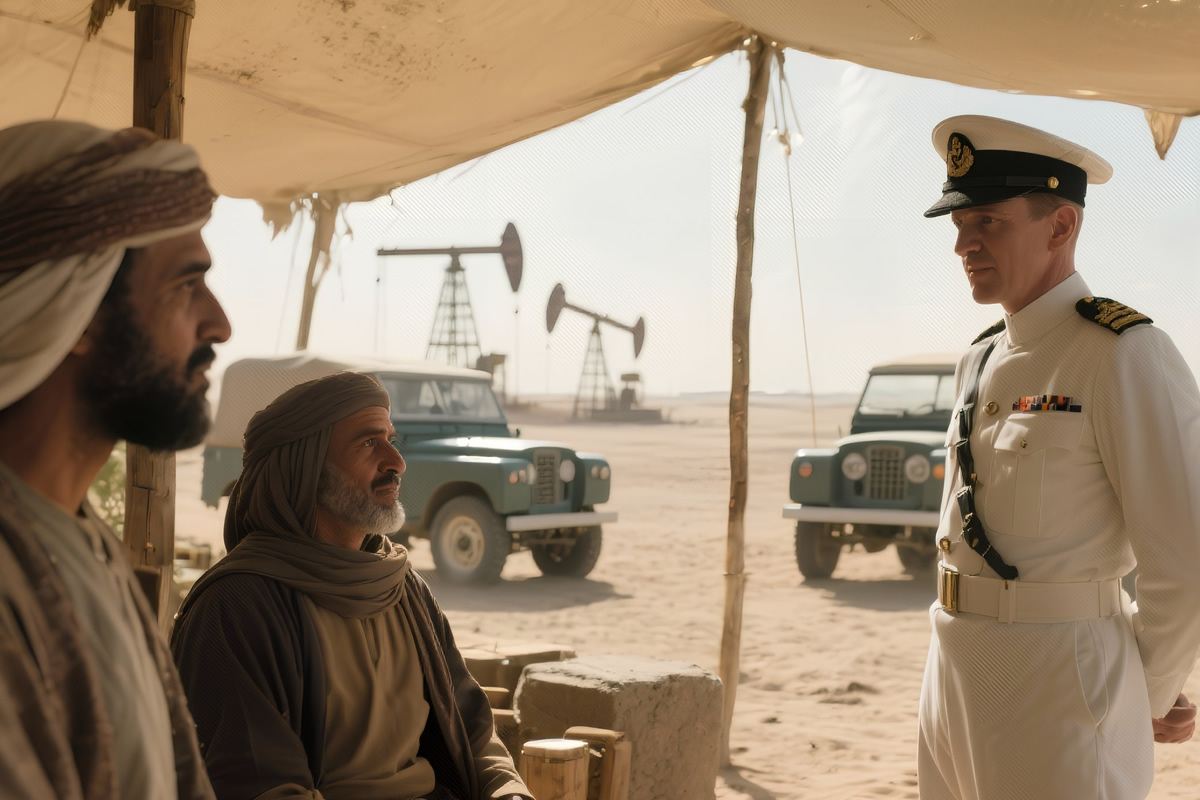
The Second World War left Britain victorious but exhausted, clutching its empire like a man holding sand — the tighter the grip, the faster it slipped away. On the Arabian coast, the Union Jack still fluttered above garrisons and consulates, but the wind had changed. The empire that once ruled oceans now ruled paperwork. Yet along the southern Gulf, British agents clung to their protectorates — Bahrain, Qatar, Kuwait, Muscat, and the Trucial States — as if empire could still be managed by telegram. In London’s ledgers, they were mere dots on the map; in reality, they were the gatekeepers of a new kind of power: oil and geography.
By the late 1940s, oil had been found in Bahrain and Kuwait, then Qatar and Abu Dhabi. British companies, cloaked as “advisers,” moved quickly to secure concessions. The tribes along the coast, once pearl divers and smugglers, were suddenly courted like kings. Airstrips replaced camel trails, and desert sheikhs signed contracts they could barely read, exchanging sovereignty for royalties. British officers in white uniforms became the real administrators, mediating tribal disputes with polite imperial patience. For the Crown, it was empire on discount — no colonies, no armies, only contracts and flags.
But the postwar world was not kind to old empires. India’s independence in 1947 began the unraveling, and by the 1950s Arab nationalism swept the region like a sandstorm. Egypt’s Gamal Abdel Nasser denounced Britain as the jailer of the Arab world, his voice echoing across radios from Cairo to the Gulf. Crowds cheered for unity; London muttered about “stability.” The Suez Crisis of 1956 humiliated Britain beyond repair — when its invasion collapsed under American pressure, the myth of imperial authority was finished. In the Gulf, the sheikhs watched and learned: the empire’s sun was setting, and they would soon stand alone beneath it.
Meanwhile, the desert was changing. In the Trucial States — the cluster of small sheikhdoms along the coast of today’s UAE — air-conditioned offices rose beside mud-brick forts. British Petroleum and Royal Dutch Shell surveyed the dunes, drilling test wells with the confidence of gods. Oil was slow to come, but the future was visible in the chrome and concrete. Roads stitched together tribal territories that had never known borders. Radios brought Cairo’s politics and Beirut’s music to fishing villages where the only news used to be the tides. The twentieth century had arrived, uninvited and unstoppable.
Yet London still pretended to rule. Political agents in Bahrain and Sharjah wrote endless reports about “tribal rivalries,” as if history itself could be delayed with paperwork. They signed defense treaties, managed local currencies, and policed the seas under the banner of the Royal Navy. The façade held, but barely. The Arabs knew the British were tired. The Americans were already circling — richer, fresher, and hungrier. The empire’s successor was waiting politely in the wings.
In the 1960s, oil began to gush in Abu Dhabi. Sheikh Zayed bin Sultan Al Nahyan, newly installed ruler, understood its meaning better than any diplomat. Unlike most monarchs, he saw oil not as personal treasure but as the tool of transformation. He used the new wealth to build schools, hospitals, and houses — not for elites, but for tribesmen who had spent centuries chasing mirages. Where others bought palaces, Zayed bought time: time to unite the fractious emirates before the foreigners left.
In 1968, London announced it would withdraw all forces “east of Suez” by 1971. The decision hit the Gulf like a thunderclap. The British Empire, architect of the protectorates, was walking away. Panic followed — rivalries reignited, borders blurred, and old feuds resurfaced. But in that chaos, Sheikh Zayed saw a chance for creation. He reached out to the neighboring rulers — Rashid of Dubai, Shakhbut of Abu Dhabi, Khalid of Sharjah — urging them to form a federation strong enough to survive without the British. It was a fragile vision built on trust, negotiation, and shared survival — the rarest currency in Arabian history.
On December 2, 1971, the United Arab Emirates was born. Seven emirates signed the constitution, blending ancient tribal authority with modern statehood. The Union Jack came down; a new flag rose over Abu Dhabi. Britain’s afterglow faded into memory, replaced by the fluorescent dawn of the Emirates. What had been the empire’s forgotten sandbars became the world’s newest experiment — a monarchy built not on conquest, but cooperation.
The British left their maps, their bureaucracy, and their tea sets. But the Arabs kept the most useful lesson: empire is not a thing you inherit, it’s a thing you build. The Trucial States, once the quiet edges of someone else’s empire, had transformed into a federation that would soon rival the world’s richest nations. The desert had outlived yet another empire — politely, profitably, and without firing a shot.
The Emirates: Sand, Glass, and Vision (1971–2001)
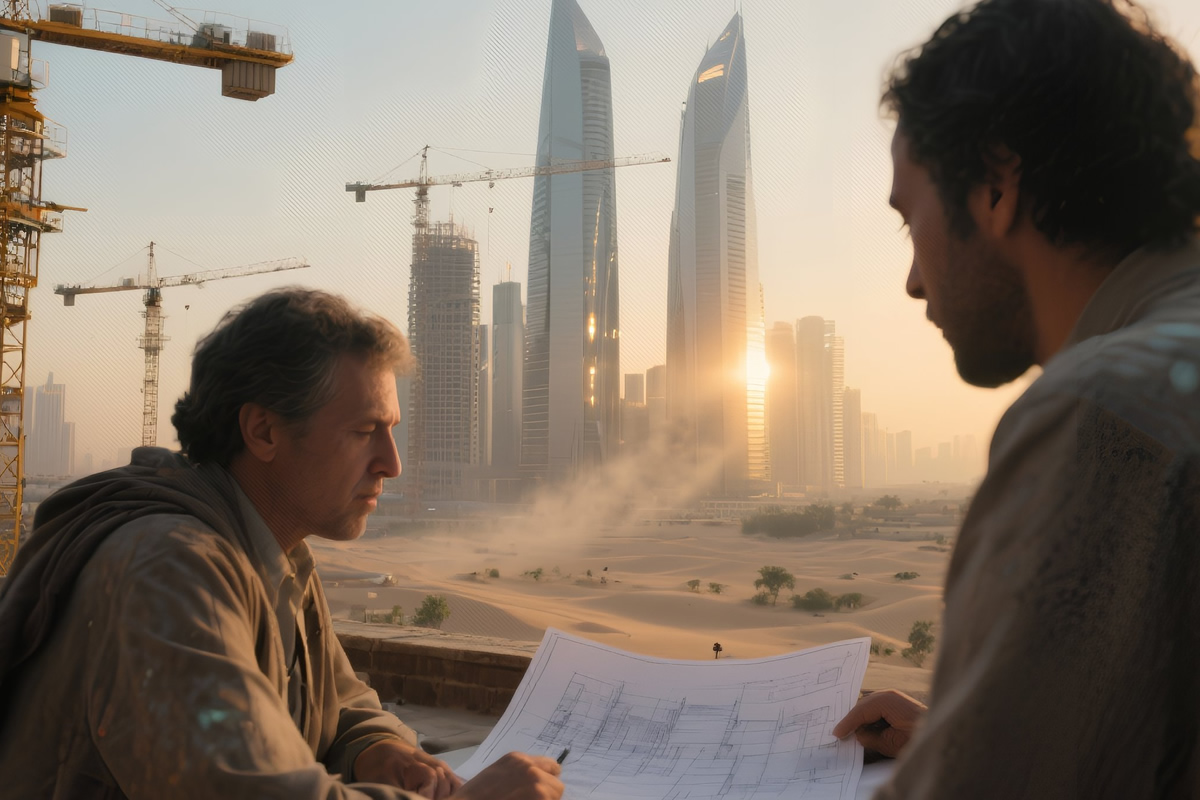
The birth of the United Arab Emirates in December 1971 was less a revolution than a quiet act of genius. No blood was spilled, no palace stormed, no empire collapsed — only a decision made beneath desert skies by men who understood that survival now required unity. Sheikh Zayed bin Sultan Al Nahyan of Abu Dhabi became president, Sheikh Rashid bin Saeed Al Maktoum of Dubai his closest partner. Together they turned seven struggling sheikhdoms — once rival fishing villages and smugglers’ coves — into a federation unlike anything the Arab world had seen: stable, modern, and absurdly ambitious.
At first, the odds were laughable. The population barely exceeded two hundred thousand; literacy was scarce, and infrastructure existed mostly as ideas. Yet beneath the sand lay oil — the liquid promise that could turn faith into future. Zayed’s first decree was not to hoard but to build. Oil revenues funded schools, hospitals, and housing for every citizen. Desalination plants turned seawater into life; electricity chased away the desert night. Roads cut across the dunes where only camel tracks had existed. The tribes that once fought over wells now shared airports.
Dubai, under Sheikh Rashid, had less oil but more imagination. “My grandfather rode a camel,” he said, “my father drove a car, I drive a Mercedes. My son will drive a Land Rover, and his son will again ride a camel — unless we act.” So he acted. He dredged harbors, built the Jebel Ali port, and founded an airline in a city that had no tourists. Rashid wagered that the future of Dubai was not oil but opportunity. By the late 1980s, his bet began to pay off. Free trade zones attracted companies from every continent; skyscrapers rose like steel prayers to the god of commerce.
Zayed’s vision was broader and quieter. He ruled not as a monarch of fear but as a patriarch of trust. His council meetings were open-air gatherings where Bedouins sat beside ministers. His philosophy was simple: wealth must serve the people, or it poisons the nation. While other Arab leaders drowned their countries in vanity projects and secret police, Zayed planted trees in the desert and offered citizenship to those who worked with loyalty. The Emirates became the rarest creation in the modern Middle East — a state where progress did not devour its soul.
By the 1990s, the federation stood as a paradox that worked. Abu Dhabi financed stability; Dubai built spectacle. Sharjah became the cultural heart, Fujairah the quiet port, Ras Al Khaimah the industrious outsider. Together they formed a model few believed possible: monarchies cooperating without collapsing. The Gulf War of 1990 tested them brutally. When Saddam Hussein invaded Kuwait, the UAE joined the coalition that pushed him back, proving that neutrality would mean extinction. The lesson was clear — independence required alignment with power, not defiance of it.
Foreigners poured in: engineers, bankers, architects, dreamers. The skyline of Dubai changed faster than history could record it. The desert that once measured wealth in camels now counted it in cranes. Glass replaced sand, air-conditioning replaced wind, and English replaced silence. Yet the federation remained strangely itself — conservative in faith, lavish in lifestyle, unshaken in purpose. While neighboring states fought revolutions and coups, the UAE mastered the art of controlled evolution.
Sheikh Rashid died in 1990, Sheikh Zayed in 2004, but by the turn of the millennium their experiment was already a legend. The Emirates had become an oasis of order in a region addicted to chaos. It hosted global summits, brokered peace deals, and imported the best of the world without surrendering its identity. Women entered universities, foreigners built fortunes, and the call to prayer echoed between glass towers. The past had not vanished; it had simply learned how to operate an elevator.
By 2001, the United Arab Emirates stood as proof that a nation need not choose between tradition and modernity — that the desert could host both a mosque and a stock exchange. Its wealth glittered, but its strength lay elsewhere: in foresight, in tolerance, in leadership that preferred consensus to conquest. From seven scattered emirates rose one improbable country, its foundations set not in oil but in wisdom. What began as a British protectorate had become the blueprint for survival in the post-oil age — a federation built on sand, tempered by glass, and guided by vision.
War, Religion, and the Price of Modernity (2001–2015)
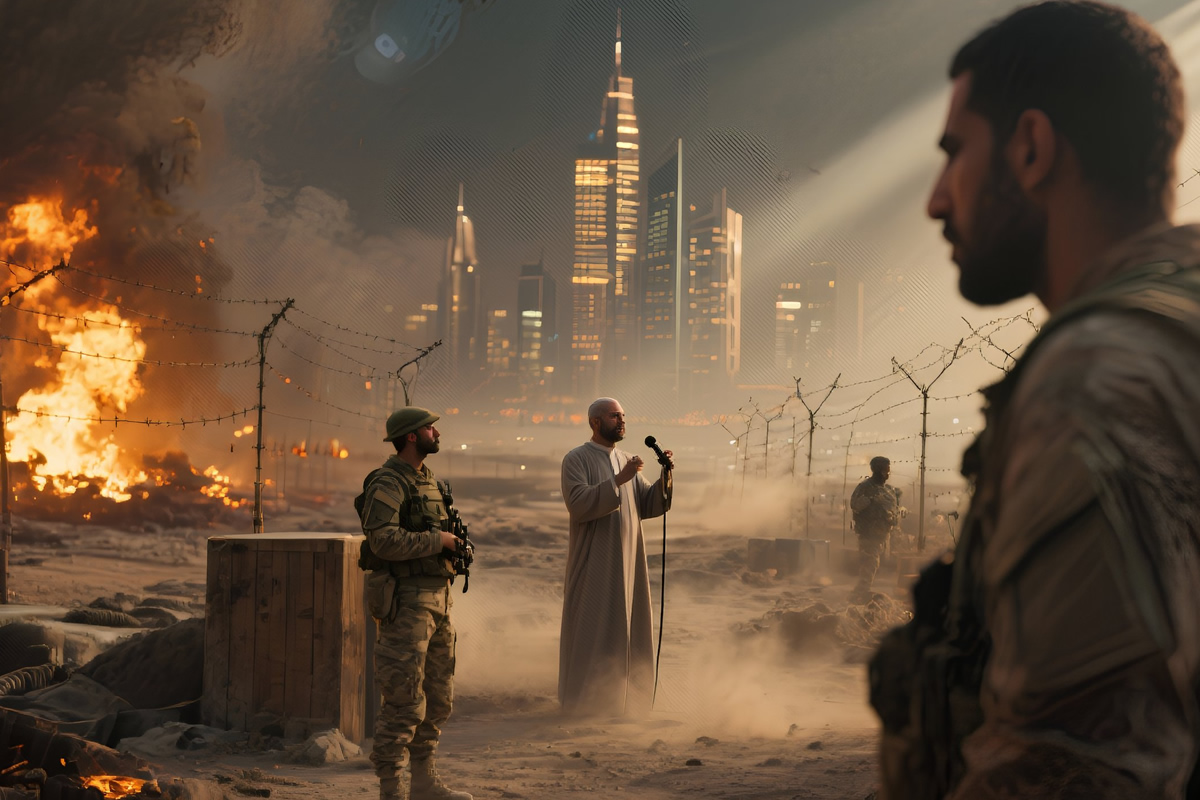
The twenty-first century arrived not with dawn but with fire. On September 11, 2001, the world watched as two planes turned the New York skyline into smoke — and in the wreckage, a new age began. Fifteen of the nineteen hijackers were Saudi citizens; none were poor. The attacks shattered the myth that wealth could buy stability. Suddenly, the kingdom that had fed the modern world’s engines found itself blamed for fueling its rage. The West saw terrorism; the Saudis saw betrayal — their own children, educated abroad and raised on both oil wealth and spiritual austerity, had declared war on the world.
In Washington, retribution became doctrine. The U.S. invaded Afghanistan, then Iraq, claiming to reshape the Middle East into democracy. Instead, it opened the gates of chaos. In Saudi Arabia, American troops on holy soil inflamed the faithful; in Iraq, sectarian hatred devoured the state. Across the Arab world, Islam was dragged into a global courtroom, forced to defend its very name. Wahhabism — once a source of unity — was now whispered as accusation. The desert that once exported oil now exported ideology, and both proved volatile.
The Gulf monarchies faced an impossible equation: remain faithful to the past or adapt to a world that distrusted them. The United Arab Emirates chose pragmatism. While clerics shouted, Dubai built. Its rulers realized that survival lay not in preaching but in distraction — in skyscrapers, banks, and shopping festivals. The city turned commerce into a kind of secular salvation. Tourists replaced pilgrims; investment replaced faith. Every new tower was a sermon in steel, proclaiming that progress could redeem the desert better than prayer.
Abu Dhabi, wealthier and more cautious, walked a different path. It bankrolled the federation’s stability, invested in renewable energy, and quietly built influence across Africa and Europe. The UAE became the model the West could love — Muslim but modern, authoritarian yet efficient. Its airports became the crossroads of globalization, its airlines the arteries of ambition. The desert learned to fly, and the world was happy to forget what lay beneath the wings: laborers from Asia working in silence, their sweat building someone else’s paradise.
Saudi Arabia, meanwhile, wrestled with its own contradictions. Crown princes argued over reform, clerics resisted every gesture toward openness, and oil prices swung like a guillotine. The state that had once dictated global energy markets now found itself hostage to them. Bin Laden’s death in 2011 ended one nightmare but did not bring peace. The kingdom poured billions into security and diplomacy, trying to smother the fires of radicalism it had helped ignite. But the real threat was not outside its borders — it was demographic, generational, and psychological. A young population, raised online and restless, looked at the palaces and wondered what all the obedience had bought them.
Then came the Arab Spring. In 2011, millions across the Middle East rose against dictators, shouting for dignity and bread. The monarchies of the Gulf watched in horror as Tunisia burned, Egypt fell, Libya imploded, and Syria bled. In Riyadh and Abu Dhabi, the lesson was immediate: reform kills faster than repression. The UAE outlawed political parties; Saudi Arabia banned protests and flooded the streets with subsidies. Freedom was replaced with prosperity, democracy with employment. It worked — for now. The cities gleamed, the people shopped, and the desert stayed quiet.
But the illusion of control was thin. The wars in Yemen and Syria dragged on, feeding resentment and extremism. Iran grew bolder, arming proxies across the region, while America’s enthusiasm for endless wars waned. The Gulf states responded by buying influence instead of ideology — funding think tanks, media outlets, and sports teams abroad. Power became public relations; legitimacy, a brand. Religion remained the costume, but the stage belonged to oil, technology, and soft power. The faith that once united the desert was now just one shareholder among many.
By 2015, the Middle East stood at an uneasy crossroad. The Emirates had become the success story — the glittering showcase of controlled modernity — while the rest of the region drowned in history’s undertow. Saudi Arabia prepared for a generational shift under a young prince named Mohammed bin Salman, promising reform through absolute rule. The West, still addicted to oil and illusions, applauded. But beneath the neon and the slogans, the same old truth lingered in the dust: nothing in Arabia is permanent — not wealth, not power, not peace. The desert waits, as it always has, for the next empire to believe it can be tamed.
Beyond Oil: The New Visionaries (2015–Present)
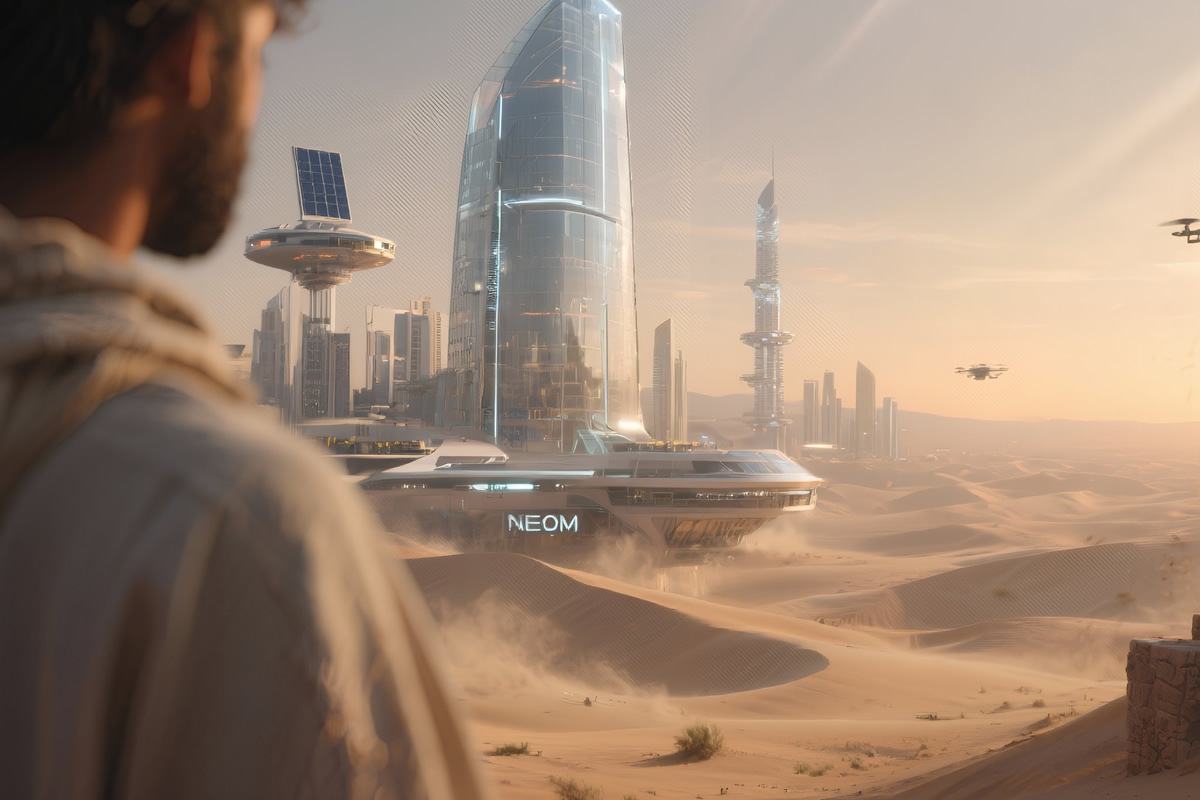
By the middle of the second decade of the twenty-first century, the mirage of infinite oil was dissolving. Prices collapsed, reserves matured, and the world began speaking the heresy that once seemed unthinkable — the post-oil future. For Arabia, it was a summons more than a threat. The same desert that had buried empires before was now asking a new question: could wealth built on extraction be reborn through imagination? For the first time since the age of prophets, the answer might depend not on revelation, but on design.
In Saudi Arabia, a young crown prince emerged with the arrogance of youth and the precision of a strategist. Mohammed bin Salman, barely in his thirties, announced Vision 2030 — a blueprint to remake the kingdom from the ground up. His promise was intoxicating: a modern economy, a more open society, an end to dependency on oil. The methods were brutal, the marketing flawless. Palaces became prisons for rival princes, journalists disappeared, and billions were poured into projects that blurred the line between reality and simulation. NEOM, a linear city stretching across the northern desert, was advertised as a utopia powered by sunlight and surveillance. To the world, it looked futuristic; to history, it looked familiar — another attempt to control the uncontrollable.
The United Arab Emirates, already decades ahead, refined its role from survivor to symbol. It launched the Hope probe to Mars in 2020, built artificial islands visible from space, and declared ministries of happiness, tolerance, and artificial intelligence. In Dubai, data replaced oil as the new currency; in Abu Dhabi, renewable energy replaced prophecy. The UAE became the laboratory of the twenty-first century — authoritarian but efficient, traditional yet algorithmic. It proved that progress in the Middle East need not explode; it could be engineered.
Elsewhere, the region fractured under the pressure of contradictions. Yemen became a wound that refused to close, torn apart by war and hunger. Syria turned to ash, Lebanon to debt, Iraq to exhaustion. Iran and Saudi Arabia circled each other like ancient predators, fighting through proxies in every ruin. The dream of Arab unity, once shouted from Cairo rooftops, had shrunk to a quiet alliance of monarchs and technocrats who understood that stability was now the only ideology left.
At home, the transformation of daily life was staggering. Women in Saudi Arabia drove cars for the first time, concerts returned to Riyadh, and cinemas reopened under royal decree. Drones patrolled the skies while influencers filmed from coffee shops built where the sand once swallowed caravans. In Dubai, robots served espresso; in Mecca, pilgrims used smartphone apps to navigate the rituals of faith. The desert had digitized itself — its silence replaced by the hum of servers and the low, unending vibration of ambition.
Yet beneath the glitter, the questions persisted. Could a society founded on obedience coexist with creativity? Could artificial cities replace culture, or algorithms replace ethics? The Gulf monarchies promised transformation, but their engines still ran on the same fuel: control. Citizens became clients; belief became branding. The mosque and the market finally merged into one — a place where God was optional, but Wi-Fi was mandatory.
By the early 2020s, the pandemic tested even these engineered utopias. Flights stopped, oil prices crashed, and the glass towers of Dubai stood eerily silent. But the pause became a lesson. The Emirates doubled down on technology, health, and logistics, turning crisis into opportunity. Saudi Arabia used the moment to accelerate its megaprojects, arguing that faith in the future was itself a form of worship. The rest of the world, distracted by its own chaos, barely noticed that the desert had quietly reinvented itself again.
Today, the Arabian Peninsula stands at the edge of another metamorphosis. The gods of the past — empire, religion, and oil — have all been replaced by data, vision, and speed. Mecca still calls the faithful, but the new pilgrims arrive with business cards and digital visas. The men who once followed the stars now follow algorithms. Yet beneath the neon and silicon, the same truth holds: the desert keeps its memory. It remembers every empire that promised eternity and vanished in a generation. Arabia’s new visionaries may believe they have mastered the sands, but the sands, patient as time itself, are only waiting to see how long the illusion lasts.
The Memory of the Desert
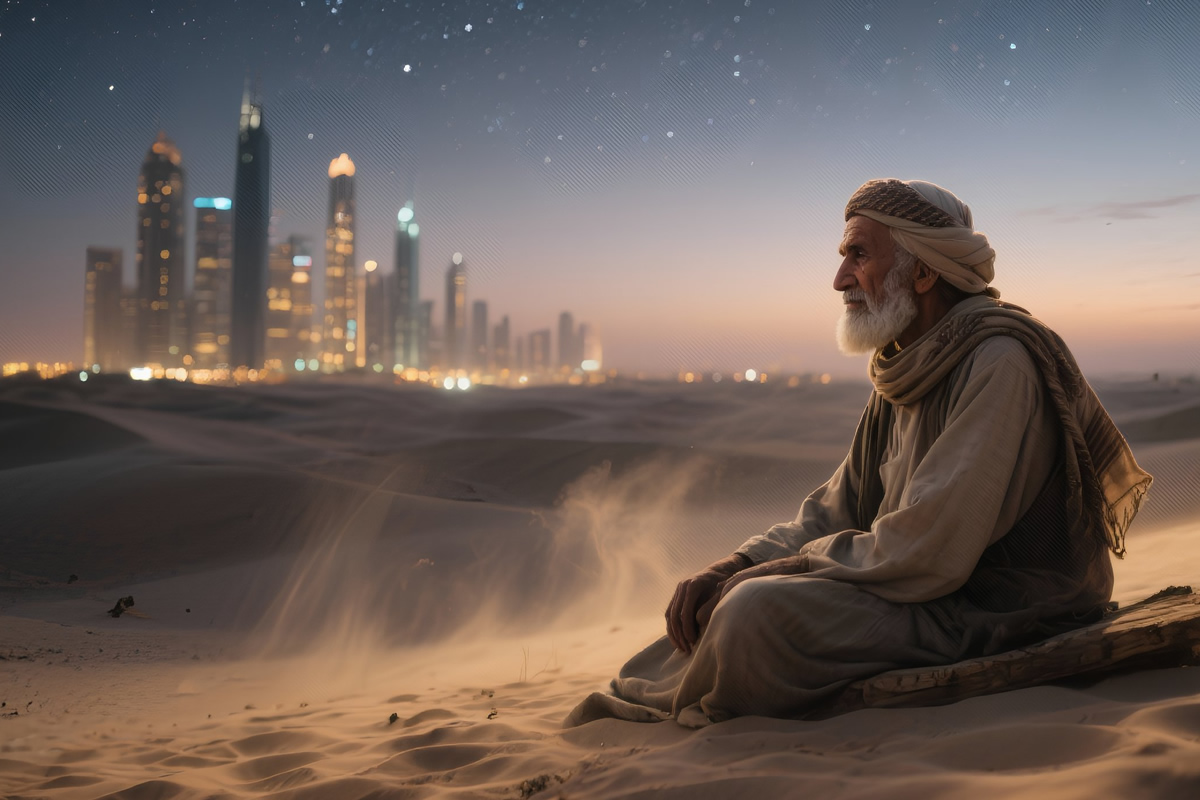
At dusk, when the sun bleeds into the dunes and the sky burns the color of copper, an old Bedouin sits on a ridge outside Abu Dhabi. Behind him, towers of glass shimmer like ghosts; ahead of him, the horizon folds into silence. In his youth, there were no roads, no lights, no hum of engines — only the wind and the memory of caravans. Now, the same wind tastes of salt and fuel, and he wonders if the world has changed, or merely found a louder way to repeat itself.
The desert around him has seen it all. It watched gods rise from smoke, prophets walk barefoot across the sand, empires stretch their maps over its emptiness, and merchants pave the dunes with pipelines. Each believed they had conquered it. Each learned that nothing survives here except patience. Even glass, even steel, will one day turn back into dust. The Bedouin knows this, though no one asks him anymore. His grandchildren speak English, trade stocks, and post prayers on screens brighter than the moon. They call him romantic; he calls them temporary.
In Mecca, the faithful still circle the Kaaba, tracing the same path their ancestors walked fourteen centuries ago. Pilgrims fly in from every corner of the world, their smartphones glowing with digital directions to God. Faith has survived the fiber optics, though it now travels by Wi-Fi. The merchants of the new age sell different miracles — data, energy, prestige — but the ritual remains the same: bow, pay, believe. The form changes, the instinct never does.
The British are gone, the Ottomans are dust, the caliphs are names in textbooks. What remains is the paradox they all ignored — that Arabia is most powerful when it seems weakest, and most alive when it appears barren. Its true wealth has never been oil or empire, but endurance. Empires mistake silence for emptiness; Arabia knows silence is strategy. The sand erases what it no longer needs.
In the Emirates, the night glows like a circuit board. Planes cross the sky in silver lines, and cranes hum like insects. The Bedouin looks at them with neither envy nor resentment. He understands what the architects do not: every city is a mirage that must be constantly rebuilt to remain visible. The desert allows this game because it knows it will win in the end. Time, not technology, decides who owns tomorrow.
Beyond the lights, the dunes shift. Their movement is imperceptible, but relentless — the slow breath of eternity. Beneath them lie the bones of Sabaean kings, Roman soldiers, and oil engineers; all reduced to the same fine dust. The desert keeps no hierarchy, no nostalgia. It remembers everything, forgives nothing, and forgets on its own schedule.
For now, the Arabian Peninsula stands crowned in glass and satellites, worshipped for its innovation, envied for its wealth. But its truest legacy is older and simpler: the refusal to die. From incense to oil to silicon, Arabia has endured every empire that tried to define it. It has outlasted gods, prophets, and pipelines. It will outlast this age as well.
And when the towers fall silent and the lights fade, the wind will return to speak in the language it has always known — not of progress, or faith, or conquest, but of continuity. The same voice that once whispered to Muhammad in the cave of Hira, that guided caravans through the night, will still be there, shaping dunes around the ruins of ambition. The desert never forgets. It only waits.

